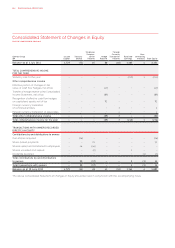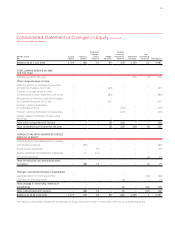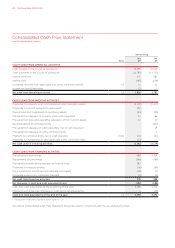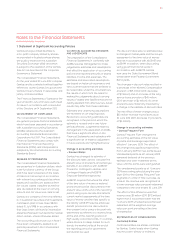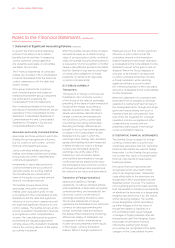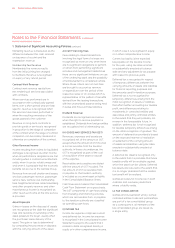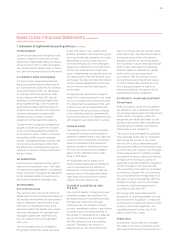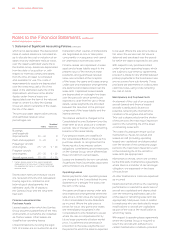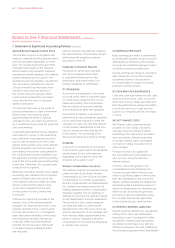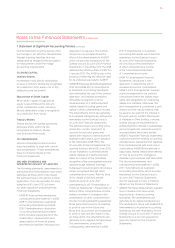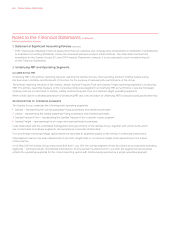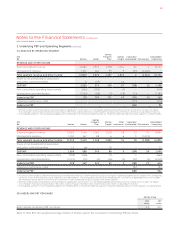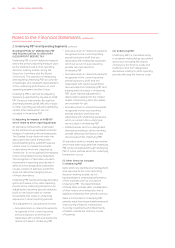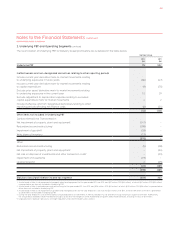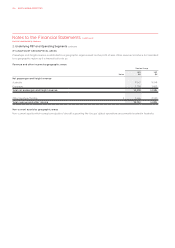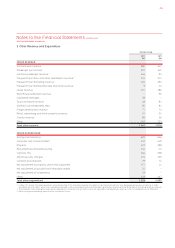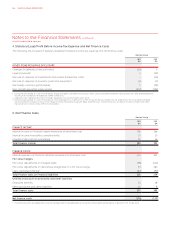Qantas 2012 Annual Report Download - page 80
Download and view the complete annual report
Please find page 80 of the 2012 Qantas annual report below. You can navigate through the pages in the report by either clicking on the pages listed below, or by using the keyword search tool below to find specific information within the annual report.
FOR THE YEAR ENDED 30 JUNE 2012
Notes to the Financial Statements continued
Defined Benefit Superannuation Plans
The Qantas Group’s net obligation with
respect to defined benefit superannuation
plans is calculated separately for each
plan. The Qantas Superannuation Plan
has been split based on the divisions
which relate to accumulation members
and defined benefit members. Only defined
benefit members are included in the
Qantas Group’s net obligation calculations.
The calculation estimates the amount
of future benefit that employees have
earned in return for their service in
the current and prior periods, which
is discounted to determine its present
value and the fair value of any plan
assets is deducted.
The discount rate used is the yields at
balance sheet date on State Government
Bonds which have maturity dates
approximating the terms of Qantas’
obligations. The calculation is performed
by a qualified actuary using the projected
unit credit method.
In calculating the Qantas Group’s obligation
with respect to a plan, to the extent that
any cumulative unrecognised actuarial
gain or loss exceeds 10 per cent of the
greater of the present value of the defined
benefit obligation and the fair value of
plan assets, that portion is recognised in
the Consolidated Income Statement over
the expected average remaining working
lives of the active employees participating
in the plan. Otherwise, the actuarial gain
or loss is not recognised.
Where the calculation results in plan assets
exceeding plan liabilities, the recognised
asset is limited to the net total of any
unrecognised actuarial losses and past
service costs and the present value
of any future refunds from the plan
or reductions in future contributions
to the plan.
Past service cost is the increase in the
present value of the defined benefit
obligation for employee services in prior
periods, resulting in the current period
from the introduction of, or changes to,
post-employment benefits or other long-
term employee benefits. Past service
costs may either be positive (where
benefits are introduced or improved)
or negative (where existing benefits
are reduced).
Various actuarial assumptions underpin
the determination of the Qantas Group’s
defined benefit obligation and are
discussed in Note 30.
Employee Termination Benefits
Provisions for termination benefits
are only recognised when there
is a detailed formal plan for the
termination and where there is no
realistic possibility of withdrawal.
T PROVISIONS
A provision is recognised if, as a result
of a past event, there is a present legal
or constructive obligation that can be
measured reliably, and it is probable
that an outflow of economic benefits
will be required to settle the obligation.
If the effect is material, a provision is
determined by discounting the expected
future cash flows required to settle the
obligation at a pre-tax rate that reflects
current market assessments of the time
value of money and the risks specific
to the liability. The unwinding of the
discount is treated as a finance charge.
Dividends
A provision for dividends is recognised
in the financial year in which the dividends
are declared, for the entire amount,
regardless of the extent to which the
dividend will be paid in cash.
Workers’ Compensation Insurance
The Qantas Group is a licensed self-insurer
under the New South Wales Workers’
Compensation Act, the Victorian Accident
Compensation Act and the Queensland
Workers’ Compensation and Rehabilitation
Act. Qantas has made provision for all
notified assessed workers’ compensation
liabilities, together with an estimate of
liabilities incurred but not reported, based
on an independent actuarial assessment.
The provision is discounted using pre-
tax rates that reflect current market
assessments of the time value of money
and the risks specific to the liabilities and
have maturity dates approximating the
terms of Qantas’ obligations. Workers’
compensation for all remaining employees
is commercially insured.
U EARNINGS PER SHARE
Basic earnings per share is determined
by dividing the Qantas Group’s net profit
attributable to members of the Qantas
Group by the weighted average number
of shares on issue during the year.
Diluted earnings per share is calculated
after taking into account the number
of ordinary shares to be issued for
no consideration in relation to dilutive
potential ordinary shares.
V CASH AND CASH EQUIVALENTS
Cash and cash equivalents include cash
at bank and on hand, cash at call and
short-term money market securities and
term deposits that are readily convertible
to a known amount of cash and are
subject to an insignificant risk of change
in value.
W NET FINANCE COSTS
Net finance costs comprise interest
payable on borrowings calculated
using the effective interest method,
unwinding of the discount on provisions
and receivables, interest receivable
on funds invested, gains and losses
on mark-to-market movement in fair
value hedges.
Finance income is recognised in
the Consolidated Income Statement
as it accrues, using the effective
interest method.
Finance cost is recognised in the
Consolidated Income Statement as
incurred, except where interest costs
relate to qualifying assets in which case
they are capitalised to the cost of the
assets. Qualifying assets are assets that
necessarily take a substantial period of
time to be made ready for intended use.
Where funds are borrowed generally,
borrowing costs are capitalised using
the average interest rate applicable
to the Qantas Group’s debt facilities.
X INTERESTBEARING LIABILITIES
Interest-bearing liabilities are recognised
initially at fair value less attributable
transaction costs. Subsequent to initial
recognition, interest-bearing liabilities
are stated at amortised cost, with any
difference between cost and redemption
value being recognised in the Consolidated
1. Statement of Significant Accounting Policies continued
QANTAS ANNUAL REPORT 2012078


